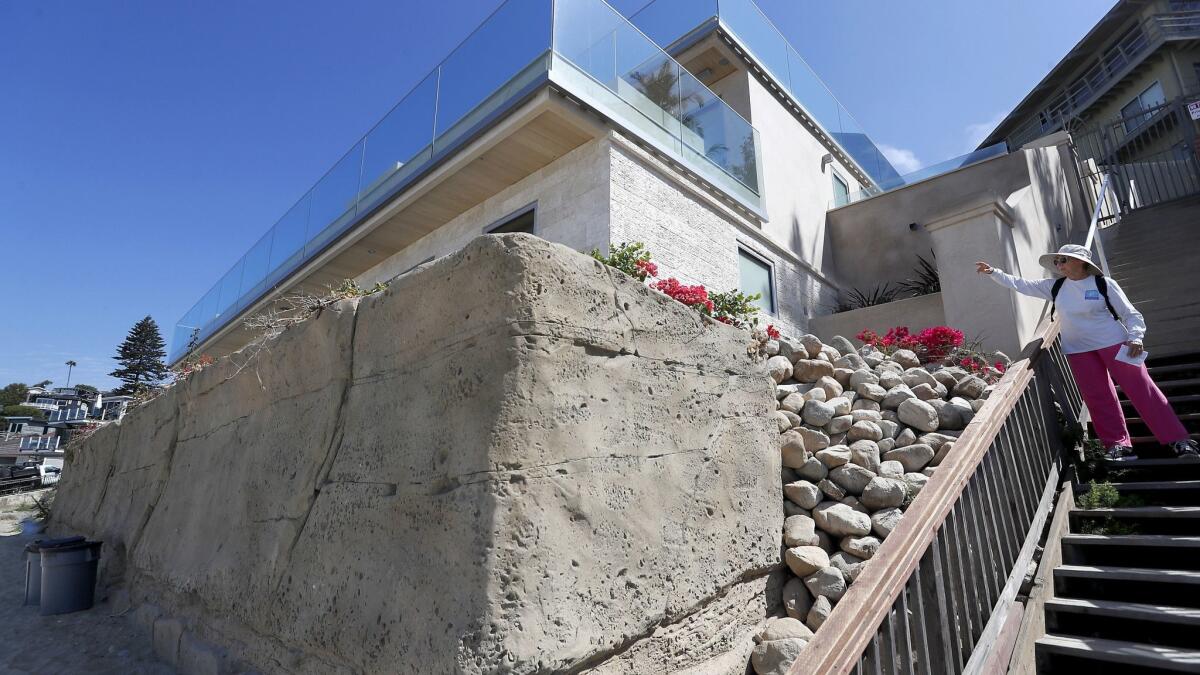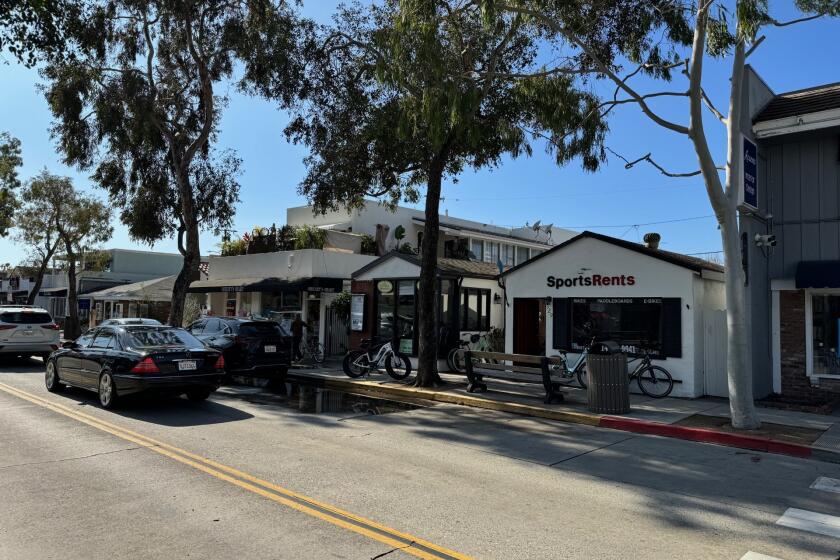Embattled Laguna seawall still stands as homeowners’ lawsuit against Coastal Commission awaits trial

The seawall at the center of a fight between the state and a pair of Laguna Beach homeowners is still standing after the owners of the oceanfront mansion sued the California Coastal Commission over its hefty sanctions for what the agency says is an unauthorized, beach-threatening structure.
The commission voted unanimously in August to impose a $1-million fine and order homeowners Jeffrey and Tracy Katz to tear down the seawall protecting 11 Lagunita Drive from the ocean’s waves. The demolition deadline would have passed in October, but an Orange County Superior Court judge stayed the punishments while the lawsuit is pending.
The suit, filed in August after the commission’s decision, alleges inverse condemnation and seeks damages of at least $25 million, the estimated market value of the home.
The Katzes argue that they had performed city-approved minor repair and maintenance to an investment property — work not significant enough to trigger a commission requirement to remove the wall if the home were to have a major remodel.
The Coastal Commission began demanding that the Katzes cease work on the home in April 2017, three months after the city granted permits through its Local Coastal Plan, a commission-granted authority.
“Thereafter, the commission’s enforcement staff waged a campaign, ordering removal of the seawall, despite obvious risks to the residence, and threatening seawall forfeiture, millions of dollars in penalties and ultimate destruction or impairment of the remodeled residence based on an utterly indefensible reading of” city and commission standards, according to the Katzes’ complaint.
The commission, the arbiter of coastal development across California, said its action was necessary.
“[The Katzes] cannot demonstrate that a stay of the commission’s cease-and-desist order is ‘not against the public interest,’” it said in response to the suit. “Indeed, the commission found the order and penalty were required to protect the public, including public access and impacts on coastal resources.”
The commission bolstered its reply with five letters from the public supporting enforcement and noted that several people spoke at the August meeting in favor of punishing the Katzes.
“The commission wanted to send a message with swift punishment to deter future violations by the Katzes and others who might be inclined to ignore either the requirements for permits for development or conditions on their permits intended to minimize impacts on the public, including impacts on public beaches,” it said.
The case is set to go to trial in June.
The roughly 5,000-square-foot house, which backs up to Victoria Beach, was built in 1952. Previous owners built the 11-foot-tall and 80-foot-long seawall in 2005 as an emergency measure. The wall was meant to be temporary and its permit lapsed. The home went into foreclosure.
Another previous owner backed away from major remodeling plans in 2014 after the commission pushed back, in part because of the seawall.
The next year, shortly before the Katzes bought the house, the commission ruled the seawall could be reinforced as long as the house — which was built before the California Coastal Act set standards for coastal development — was generally unchanged. If the owners wanted a major remodel, the wall would have to come down, the commission said.
The commission, by way of Laguna Beach’s Local Coastal Plan, defines a major remodel as increasing square footage by 50% or demolishing and/or reconstructing at least 50% of the home. The Katzes say they tore down only 9.8% of the exterior walls and 3.5% of the combined floor and roof structural systems.
The Katzes say they are hamstrung from selling or renting out the house while they battle the Coastal Commission. The home is worth about $25 million, or $70,000 per month.
The Coastal Commission takes a dim view of seawalls on the beach. Staff members say the walls protect private property at the expense of natural sand flow and access to public beaches.
In this case, commission staff says, 18 dump trucks worth of sand is trapped behind the wall, unable to “nourish” the beach.
The lawsuit says the work did not add square footage, height or stories and did not expand the footprint or convert storage space into living space. Rather, it says, it was a minor remodel over existing framing on a house that stood on artificial fill, not sand.
Twitter: @Daily_PilotHD
All the latest on Orange County from Orange County.
Get our free TimesOC newsletter.
You may occasionally receive promotional content from the Daily Pilot.




